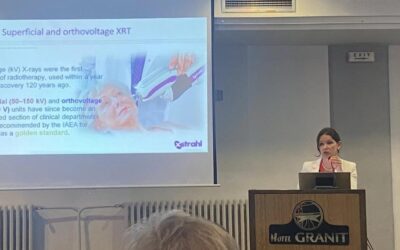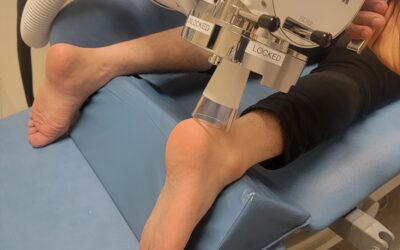PURPOSE:
We report on our experience in the treatment of T1 and T2 mycosis fungoides (MF) with total skin electron beam therapy (TSEBT), with respect to relapse-free rate, overall survival rate, and management of recurrence.
METHODS AND MATERIALS:
Between 1975 and 2001, 141 patients with MF were referred to the radiotherapy department for treatment by TSEBT. A total of 57 patients were staged as having T1 or T2 disease (24 T1 and 33 T2 patients). A total of 25 received topical therapy before irradiation. Treatment was delivered through a 6-MeV linear accelerator to a mean total dose of 30 Gy, 2 Gy/day, 4 days/week, for 4 weeks. Close follow-up was initiated without adjuvant therapy. Median age was 61 years (range, 19-84), and median follow-up was 114 months (range, 14-300).
RESULTS:
Three months after completion of TSEBT, the overall response rate was 94.7%. A complete response was achieved in 87.5% of T1 and 84.8% of T2 patients. Thirty-one patients (54.4%) experienced a skin failure (8 with T1 and 23 with T2 disease) within 1 year. Eighteen patients of 31 received a reirradiation as salvage therapy (6 localized treatment with segmental fields of electron beam irradiation and 12-second TSEB delivering 24 Gy in 12 fractions). Two were treated by topical steroids, and 11 received combination therapy with PUVA (2/10), topical (10/10) or systemic (4/10) chemotherapy, or interferon (7/10). After a second course of TSEBT (4 T1 and 10 T2 patients), the 5-year freedom from relapse rate was 70% vs. 39% in patients having received other modalities. For the whole group, 5-year DFS was 50%. The 5/10/15-year OS were 90%/65%/42%, respectively. In univariate analysis, T1 (p = 0.03), CR after first TSEBT (p = 0.04), and age younger than 60 (p < 0.001) were significant prognostic factor for OS. In multivariate analysis, age younger than 60 years was statistically associated with improved OS (p = 0.001); T stage and completion of CR remained under threshold of significance (p = 0.059 and p = 0.063, respectively). During the mean 86-month period of follow-up from relapse, a second recurrence was observed in 29% of patients.
CONCLUSIONS:
TSEBT is highly effective in early-stage MF without adjuvant therapy. Management of relapses with local radiotherapy or second TSEBT is feasible, time-saving, and cost-effective.
Ysebaert L, Truc G, Dalac S, Lambert D, Petrella T, Barillot I, Naudy S, Horiot JC & Maingon P.






